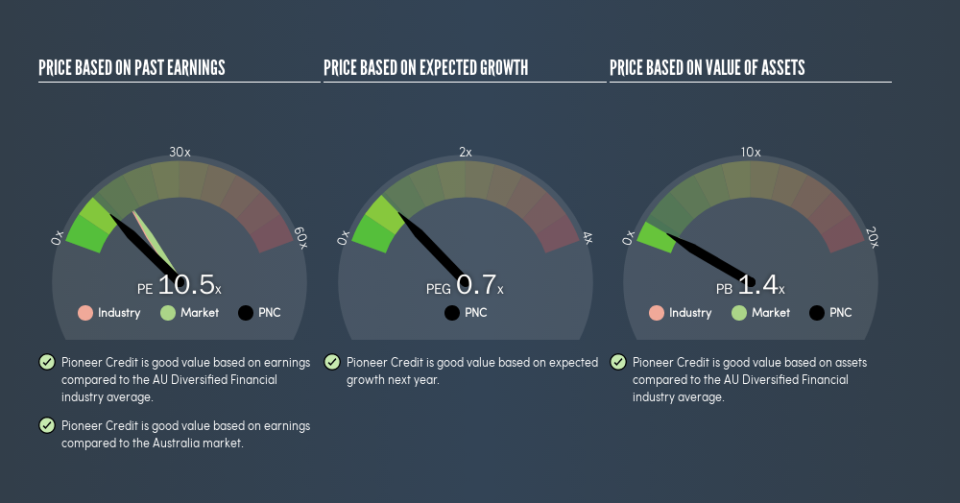Does Pioneer Credit Limited (ASX:PNC) Have A Good P/E Ratio?

Want to participate in a short research study? Help shape the future of investing tools and you could win a $250 gift card!
This article is written for those who want to get better at using price to earnings ratios (P/E ratios). We'll show how you can use Pioneer Credit Limited's (ASX:PNC) P/E ratio to inform your assessment of the investment opportunity. Based on the last twelve months, Pioneer Credit's P/E ratio is 10.46. In other words, at today's prices, investors are paying A$10.46 for every A$1 in prior year profit.
See our latest analysis for Pioneer Credit
How Do You Calculate A P/E Ratio?
The formula for P/E is:
Price to Earnings Ratio = Share Price ÷ Earnings per Share (EPS)
Or for Pioneer Credit:
P/E of 10.46 = A$2.55 ÷ A$0.24 (Based on the trailing twelve months to December 2018.)
Is A High Price-to-Earnings Ratio Good?
A higher P/E ratio means that investors are paying a higher price for each A$1 of company earnings. That isn't a good or a bad thing on its own, but a high P/E means that buyers have a higher opinion of the business's prospects, relative to stocks with a lower P/E.
How Growth Rates Impact P/E Ratios
P/E ratios primarily reflect market expectations around earnings growth rates. When earnings grow, the 'E' increases, over time. That means unless the share price increases, the P/E will reduce in a few years. A lower P/E should indicate the stock is cheap relative to others -- and that may attract buyers.
Pioneer Credit shrunk earnings per share by 4.5% last year. But over the longer term (5 years) earnings per share have increased by 25%.
How Does Pioneer Credit's P/E Ratio Compare To Its Peers?
The P/E ratio indicates whether the market has higher or lower expectations of a company. We can see in the image below that the average P/E (15.6) for companies in the diversified financial industry is higher than Pioneer Credit's P/E.
Pioneer Credit's P/E tells us that market participants think it will not fare as well as its peers in the same industry. Since the market seems unimpressed with Pioneer Credit, it's quite possible it could surprise on the upside. If you consider the stock interesting, further research is recommended. For example, I often monitor director buying and selling.
Remember: P/E Ratios Don't Consider The Balance Sheet
Don't forget that the P/E ratio considers market capitalization. Thus, the metric does not reflect cash or debt held by the company. In theory, a company can lower its future P/E ratio by using cash or debt to invest in growth.
Spending on growth might be good or bad a few years later, but the point is that the P/E ratio does not account for the option (or lack thereof).
Is Debt Impacting Pioneer Credit's P/E?
Pioneer Credit has net debt equal to 37% of its market cap. While that's enough to warrant consideration, it doesn't really concern us.
The Bottom Line On Pioneer Credit's P/E Ratio
Pioneer Credit has a P/E of 10.5. That's below the average in the AU market, which is 16.1. Since it only carries a modest debt load, it's likely the low expectations implied by the P/E ratio arise from the lack of recent earnings growth.
When the market is wrong about a stock, it gives savvy investors an opportunity. If it is underestimating a company, investors can make money by buying and holding the shares until the market corrects itself. So this free visualization of the analyst consensus on future earnings could help you make the right decision about whether to buy, sell, or hold.
Of course you might be able to find a better stock than Pioneer Credit. So you may wish to see this free collection of other companies that have grown earnings strongly.
We aim to bring you long-term focused research analysis driven by fundamental data. Note that our analysis may not factor in the latest price-sensitive company announcements or qualitative material.
If you spot an error that warrants correction, please contact the editor at editorial-team@simplywallst.com. This article by Simply Wall St is general in nature. It does not constitute a recommendation to buy or sell any stock, and does not take account of your objectives, or your financial situation. Simply Wall St has no position in the stocks mentioned. Thank you for reading.

 Yahoo Finance
Yahoo Finance 
